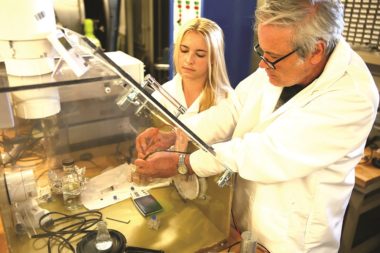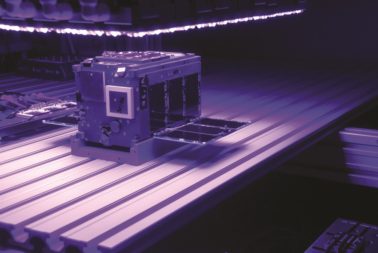When the Aerospace Corp. launched the Optical Communications and Sensor Demonstration in 2017, one mission objective was to test water-fueled thrusters. At the time, the idea was fairly novel. Two years later, water-based propulsion is moving rapidly into the mainstream.
Capella Space’s first radar satellite and HawkEye 360’s first cluster of three radio-frequency mapping satellites move in orbit by firing Bradford Space’s water-based Comet electrothermal propulsion system. Momentus Space and Astro Digital are testing a water plasma thruster on their joint El Camino Real mission launched in July. And an updated version of the water-fueled cold gas thrusters the Aerospace Corp. first flew in 2017 launched in early August.
“Water is an ideal propellant,” said Mikhail Kokorich, Momentus founder and president. “It can be used as-is in solar thermal, nuclear or electrothermal engines. In addition, water can easily be broken down into hydrogen and oxygen.”
Tethers Unlimited takes the later approach with Hydros-C, a thruster that relies on electrolysis to split water into its constituent elements before burning it in a bipropellant nozzle.
“The result is good fuel economy and good thrust,” said Robert Hoyt, Tethers Unlimited chief executive.
NASA plans to test a variety of cubesat technologies including Hydros-C on its first Pathfinder Technology Demonstrator. PTD-1 is scheduled to fly to the International Space Station in November before traveling to a higher altitude to deploy from a Cygnus cargo tug. Meanwhile, Millennium Space Systems, a Boeing subsidiary, is integrating Hydros-C in its Altair spacecraft bus.
A CLEAN, ABUNDANT FUEL
Tethers Unlimited began investigating water propulsion years ago because water poses no harm to technicians during satellite integration nor to payloads riding alongside small satellites into orbit, Hoyt said. Water propellant also fits into Tethers Unlimited’s long-term vision of creating a sustainable in-space ecosystem.
“Water is a resource around which an economy and marketplace in space could develop,” Hoyt said. Initially, water required to fuel propulsion systems will launch from Earth but later it could be extracted from the moon or asteroids, he added.

Kokorich agreed, saying water is likely to be the first and most important resource mined on asteroids and on the moon. Once mined, companies will propel spacecraft, satellites and in-space transportation vehicles, like the shuttles Momentus is developing, with water, he added.
Deep Space Industries, the firm that developed the Comet propulsion system before it was acquired by Bradford in January, celebrated the long-term vision of extracting water from celestial bodies to fuel spacecraft. Bradford is more focused on the near-term potential for water to fuel missions in Earth orbit.
“It’s non-toxic, easy to transport, easy to fuel up and you can put it on a rideshare without any trouble,” said Bradford Director Ian Fichtenbaum. Small satellites equipped with water-based propellants are welcome on small rockets, he said, adding, “many of the small launchers have no facilities for hydrazine loading and no plans for that.”
BlackSky is preparing to launch an Earth observation satellite built by LeoStella, the Spaceflight Industries-Thales Alenia Space joint venture, equipped with Bradford’s Comet thruster on the next flight of the Rocket Lab Electron rocket. At press time, the launch was scheduled for Aug. 16.
While cubesats with electric and chemical propulsion can win approval to accompany larger satellites on some rockets, the safety review process can be arduous. After enduring that review process, Aerospace Corp. engineers spent years developing steam thrusters.
The first ones flew in 2017 on the two-satellite Optical Communications and Sensor Demonstration mission, also known as AeroCube 7. AeroCube 7 launched as a secondary payload on a ULA Atlas 5 rocket that sent a classified National Reconnaissance Office satellite into orbit.
After some initial problems with ice plugging the nozzle, the Aerospace Corp. turned up the temperature on both thrusters and fired them to move the AeroCube 7 satellites toward one another, according to “The NASA Optical Communications and Sensor Demonstration Program: Proximity Operations,” a paper presented in August 2018 at the Small Satellite Conference in Logan, Utah. An updated version of AeroCube 7’s steam propulsion launched from Cygnus Aug. 7 on AeroCube 10.
Universities around the world also are developing new water-based propulsion systems.NASA awarded Purdue University funding in 2018 to launch a miniature water-fueled thruster, Film Evaporation MEMS Tunable Array, or FEMTA, on Blue Origin’s New Shepard suborbital rocket in 2021. (MEMS stands for micro-electro-mechanical system.)

“What is unique about this flight testing is that the payload will be located on the outside of the launch vehicle so that the FEMTA propulsion system can be tested in real spaceflight conditions (both vacuum and low gravity),” Alina Alexeenko, FEMTA principal investigator, said by email.
FEMTA, a tiny thruster manufactured in batches on silicon wafers, measures one centimeter by one centimeter by 0.3 millimeters. It consumes less than one watt of electrical power and provides thrust that mission operators can tune to levels as low as a few tens of micronewtons, about the weight of a single eyelash, for fine attitude control of small satellites or large deployable structures, Alexeenko said.
The University of Tokyo built a cubesat equipped with Aquarius, a resistojet propulsion system fueled by water. The Aqua Thruster Demonstrator or AQT-D cubesat, which houses an Aquarius thruster, is slated to travel to the International Space Station in September on a Japanese cargo resupply mission. AQT-D will later be deployed from the Japanese Experiment Module, according to “AQT-D: Demonstration of the Water Resistojet Propulsion System by the ISS-Deployed CubeSat,” a paper presented Aug. 4 at the Small Satellite Conference.
Water propulsion enthusiasts are celebrating all the innovation. “Just as oil powered the industrial revolution on Earth, water will power the space industrial revolution,” Kokorich said.
Until then, spacecraft manufacturers and launch providers are simply relieved to find fuel workers can handle without donning Self-Contained Atmospheric Protective Ensemble, or SCAPE suits.
Join us on Facebook or Twitter for a regular update.
#Space | https://sciencespies.com/space/water-propulsion-technologies-picking-up-steam/
No comments:
Post a Comment